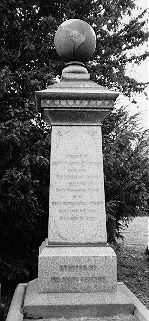Henry Walter Bates

The monument to Henry Walter Bates (1825–1892).
Note the globe on the top of the monument, with South America facing the viewer.
Few of those buried in East Finchley Cemetery travelled further in their lives than Henry Walter Bates – from Leicester to the depths of the Amazon basin.
Born in 1825, at thirteen he was apprenticed to a hosier, where his duties were to open and sweep out the warehouse. In his spare time, though, he studied in the local Mechanics Institute or, on holidays, searched for insects in Charnwood Forest. In 1843 he had a short paper, 'On Coleopterous Insects frequenting Damp Places', published in the first issue of the Zoologist magazine.
Two years later he found a job as a clerk, but it didn't suit him. Meanwhile he had become friends with another keen entomologist, Alfred Russel Wallace, an English teacher. Inspired by the journal of Darwin's voyage around the world in HMS Beagle and by a book on an Amazon expedition by one William H. Edwards, they decided to visit the Amazon themselves, collecting facts and specimens to contribute to the debate on the origin of species, and selling duplicates to defray their expenses.
They left Liverpool on 26 April 1848 and reached Pará (now Belém) near the mouth of the Amazon on 27 May.
For the next eleven years Bates explored and collected around the Amazon and its tributaries, penetrating 1,400 miles upstream. (In March 1850 he and Wallace decided to split up, and the latter returned to England in 1852 before moving on to the Malay Archipelago in 1853.)
He described his travels in The Naturalist on the Amazons, which Darwin called 'the best book of Natural History Travels ever published'.
During his four and a half years based at Ega, in the Upper Amazons, he found that 'The want of intellectual society . . . became almost insupportable. I was obliged, at last, to come to the conclusion that the contemplation of Nature alone is not enough to fill the human heart and mind.' Any periodicals, he received, such as the Athenæum, were so precious that he went over them three times, 'the first time devouring the more interesting articles; the second, the whole of the remainder; and the third, reading all the advertisements from beginning to end'.
By the time he left South America he had discovered over 8,000 species unknown to science, had learned German and Portuguese, and had made a profit of £800.
On his last night on the Pará river on his way home, 2 June 1859, he noted:
Recollections of English climate, scenery and modes of life came to me with a vividness I had never before experienced during the eleven years of my absence. Pictures of startling clearness rose up of the gloomy winters, the long grey twilights, murky atmosphere, elongated shadows, chilly springs, and sloppy summers; of factory chimneys and crowds of grimy operatives, rung to work in early morning by factory bells; of [Poor Law] union workhouses, confined rooms, artificial cares, and slavish conventionalities. To live again amidst these dull scenes I was quitting a land of perpetual summer . . .
After three years back in England, though, he found 'how incomparably superior is civilised life, where feeling, tastes, and intellect find abundant nourishment, to the spiritual sterility of half-savage existence, even though it be passed in the garden of Eden'.
For twenty-eight years, from 1864, he was assistant secretary of the Royal Geographical Society. He died of bronchitis in 1892.
Henry Bates, The Naturalist on the River Amazons (London: Everyman's Library, J. M. Dent & Sons, 1910)
Dictionary of National Biography